Andrea Zapp’s work engages with the complexities of presence formed in an interleaving of real and virtual action, meeting and place.
What are the aesthetic mechanisms that construct presence?
How does surveillance technology capture or create presence?
Can presence be located? or (re-)located?
How is presence effected by spatial and temporal perception?
A Body of Water (1999)
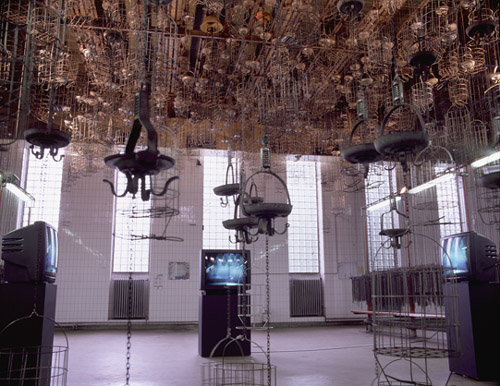
Andrea Zapp developed this project with Paul Sermon [link]
It consists of a site-specific telematic installation linking the shower room of the Ewald/Schlaegel and an iron mine in Herten with the Wilhelm Lehmbruck Museum in Duisburg. The images of visitors in the shower room in Herten are mixed with images of the Museum visitors in Duisburg and appear on one side of a water screen. Historical film footage of miners showering are projected onto the other side of the water screen.
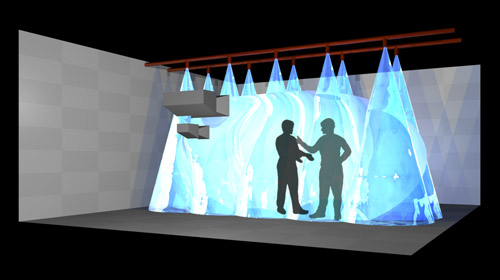
Paul Sermon and Andrea Zapp say:
'The water wall, or screen, is located in the centre of the shower room and has two different images projected onto it simultaneously from either side. The audience are able to walk around the water screen and experience the images changing from a telematic link with Duisburg to black & white documentary footage of miners showering in the original Waschkaue. Floating independently on each side of the water wall, the two images are not mixed and appear as completely different scenarios from either side of the water screen.' (in Zapp, 2005)
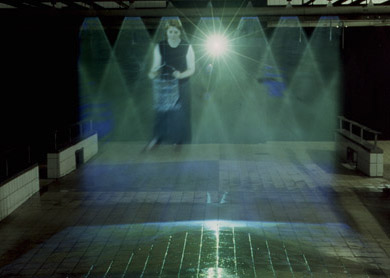
'The work simply wouldnít exist without the water interface. It transports the public interaction and at the same time it reflects the area, the Ruhrgebiet, as a network of rivers and waterways. The shower room is the heart of the installation, all the visual and conceptional layers meet here. It refers to the present changes of industrial culture in the region: On the one side the viewers are confronted by the new era, the interactive platform of networked communication - a possible future ? - yet on the other side they discover the ghostlike shadows of the past miners showering in the water - a flashback to the abandoned space and its former working culture.'
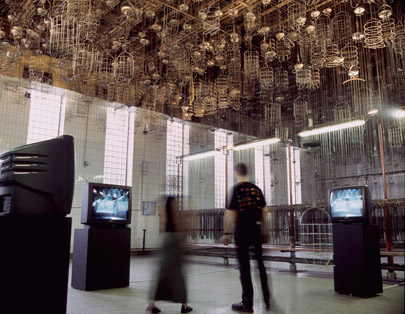
'The coal mine at Schlaegel und Eisen, and its impressive shower and changing rooms (Waschkaue), have been closed down since 1997. Over a 1000 miners were using the Waschkaue each day. It was once one of the largest coal mines in Europe, employing over 7000 miners.' (Zapp, 2005)
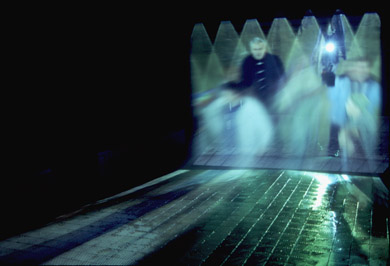
'It is the merit of the arts to present the ruling industrial metaphorical terminology better images, to speak better languages and imagine better worlds. Andrea Zapp and Paul Sermon construct a water world in A Body of Water in which volatility and fluidity of communication are carried and changed by water. The users of the installation show their other interacting partner - who is located at another site - his or her outlines as images on walls of fog that change in a constant flow. The water removes the ideological appearance of longevity and constancy from the images which are exchanged between both sites live via ISDN. It washes the image clean, one could say, and must then immediately continue with a heraclitic conclusion: One can never view the same image twice. (Just as one can never set foot in the same river twice.) Presence and history are in the current of constant change. The authenticity of the interactor and the historical relevance of the images recalled in the mind are flowing, or rather information that has flown away. We can let this information flow on, divert it dam or disperse it, but we can never freeze it: information flows!' (Fuchs in Zapp, 2005)
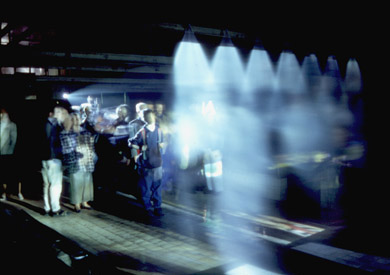
Little Sister (2000)
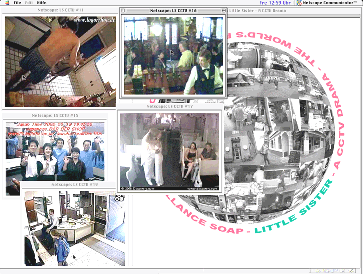
'a daily internet soap, combining live webcam images and surveillance cameras' (Zapp in Rieser and Zapp, 2002: 82)
Little Sister has been online since its inception. The piece 'combines the potential suspense of live web cam images with closed circuit television and global surveillance camera sequences, based on over twenty online links to webcams worldwide, observing private and public locations. They represent typical soap opera locations and the viewer is invited to choose their personal casting from a familiar array of urban images. The content is build up by linking to live documentary "found footage" from the web and its hidden user/characters to establish an open-ended narrative, social system and performance platform, but at the same time it plays with the notions of voyeuristic media technology and "Reality"-TV.' (Zapp, 2005)
See the piece offline at [link] and online at [link]
The Imaginary Hotel (2002)
This piece is a networked interactive installation in which users are invited to 'make up their own room'
In The Imaginary Hotel the hotel 'stands for an anonymous social melting pot in a constant state of flux, similar to the digital network Like a blank canvas, the vacant room is successively shaped by its short-term inhabitants of various identities. Real and virtual guests arrive, meet, and disappear from out of nowhere and leave their personal traces, reflecting the seamless border between physical and suggestive places of being.' (Zapp, 2004: 64)
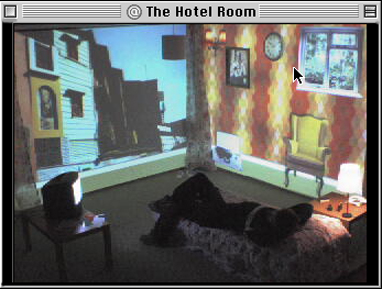
'Similar to a blank canvas, the vacant room is successively populated and shaped by individuals. Real and virtual guests arrive, meet and disappear from out of nowhere and leave their personal traces, reflecting the seamless border between physical and imaginative places of being.' (Zapp, 2005)
The Imaginary Hotel is 'explicitly designed as a wide-open stage, framed by the carpet and accentuated in the two fragile walls, curtains, and props reminiscent of a shoddy TV set.' (Zapp, 2004: 69)
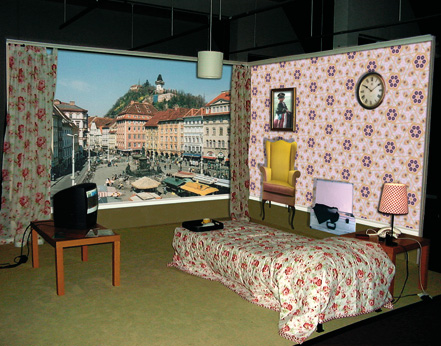
Photo Silvia Eckermann
See project at [link]
05 March/10:43 pm (2004)
This piece 'consists of a small, suburban model house on a table, linked to a computer. Looking into one of the windows the viewer discovers a small live projection, floating in the room, showing a person who is collapsed on a chair, with a computer screen and web camera running next to him.'
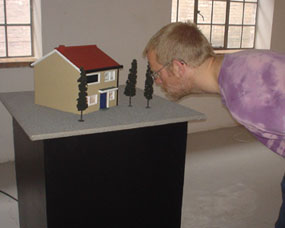
'The webcam image recaptures a recent online incident in which a young man killed himself with a lethal overdose of prescription drugs - at home in front of a net audience, apparently encouraged by fellow users in a chat room.'
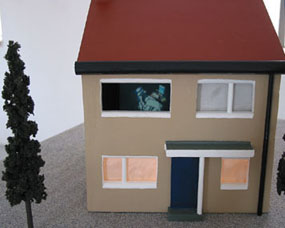
'The physical setting represents the personal space - and at the same time the miniature dimensions recall the Internet as the virtual home to model a second self. But the disturbing visuals inside the house are contradicting the neat and playful scenery. They reveal an online presence that has come to a shocking and tragic end. The actual facts and consequences can only be anticipated within an imaginary surrounding that turns more and more into a disconcerting construct of reality.' (Zapp, 2005)
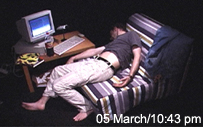
Human Avatars
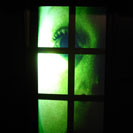
Is a networked media art installation by Andrea Zapp, with a soundtrack by Vini Reilly of Manchester’s Durutti Column.
The installation was launched in Manchester, UK, in October 2005 as part of the exhibition ‘Storyrooms,’ curated by Andrea at the Museum of Science and Industry.

For Human Avatars, visitors becomes subject to a series of live, interactive mediations, in which their presence becomes the object of attention for other remote visitors, whose watching is fed back and amplified through the installation.
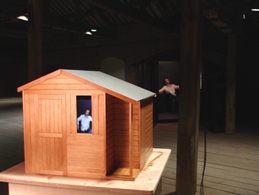
Andrea Zapp describes the piece:
'Human Avatars creates a visual dialogue between real and virtual participants on two networked stages':
'Visitors in the exhibition space discover a small wooden hut, which they are invited to enter. A live image of their body inside is projected into a remote model version of the hut, complete with model furniture, where other visitors can make contact with the tiny moving figures by peeping through a small window. Yet unaware that a second camera inside displays their peering faces back on the window of the big shed, with their eyes now overshadowing the participants inside. The architecture and the scenario appear very playful, but the immediate interactive experience is controversial, once the voyeuristic strategy behind the idyllic backdrop becomes evident - indirectly hinting at rather ambivalent and melancholic side effects of surveillance and visual control as an intrinsic part of media and entertainment.' (Zapp, 2005)
All images are courtesy of Andrea Zapp
See Andrea's books
New Screen Media: Cinema/Art/narrative, with Martin Rieser
[link] and her edited volume
Networked Narrative Environments which you can order from publications@cornerhouse.org
Andrea's CV is at
[link]
References



















